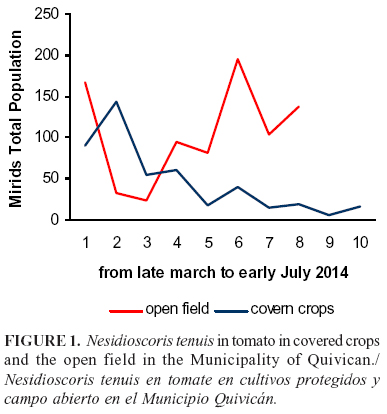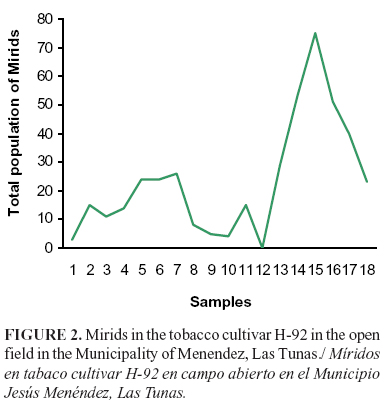Mi SciELO
Servicios Personalizados
Articulo
Indicadores
-
 Citado por SciELO
Citado por SciELO
Links relacionados
-
 Similares en
SciELO
Similares en
SciELO
Compartir
Revista de Protección Vegetal
versión impresa ISSN 1010-2752
Rev. Protección Veg. vol.29 no.3 La Habana sep.-dic. 2014
SHORT COMMUNICATION
Predatory mirids (Hemiptera: Heteroptera: Miridae) in tomato and tobacco in Cuba
Míridos depredadores (Hemiptera: Heteroptera: Miridae) en cultivos de tomate y tabaco en Cuba
María A. MartínezI, Leticia DuarteI, Heyker L. BañosI, Aramis RivasII, Adayakni SánchezI
IDirección de Sanidad Vegetal. Centro Nacional de Sanidad Agropecuaria (CENSA). Apdo 10, San José de las Lajas, Mayabeque, Cuba. Correo electrónico: maria@censa.edu.cu.
IIUniversidad de las Tunas, Cuba.
ABSTRACT
In order to update the presence of species of mirid predators and their impact on solanaceous crops of interest, samples were taken from tomato and tobacco in open fields and from tomato in covered crops of selected locations of Mayabeque and Las Tunas Provinces every seven days. In each sampling, mirid specimens were counted and collected for their subsequent identification and determination of incidence. The results showed the presence of the species Nesidiocoris tenuis Reuter, Macrolophus praeclarus (Distant) and Cyrtopeltis = Engyatus varians (Distant). The mirids were present in most samples taken in tomato and tobacco, while the incidence remained over 40% in both crops.
Key words: Hemiptera, Miridae, tomato, tobacco, covered crops, field, incidence, Cuba.
RESUMEN
Con el objetivo de actualizar la presencia de especies de míridos depredadores y su incidencia en solanáceas de interés, se realizaron 10 muestreos en los cultivos de tomate y tabaco a campo abierto y en casas de cultivos protegidos de tomate, en localidades seleccionadas de las provincias Mayabeque y Las Tunas desde finales de marzo a inicios de julio 2013. En cada muestreo se procedió al conteo de míridos y la recolecta de ejemplares para su posterior identificación y determinación de la incidencia. Los resultados evidenciaron la presencia de las especies Nesidiocoris tenuis Reuter, Macrolophus praeclarus (Distant) y Cyrtopeltis= Engyatus varians (Distant). Los míridos estuvieron presentes en la mayoría de los muestreos realizados en el tomate y el tabaco. La incidencia se mantuvo por encima del 40 % en ambos cultivos.
Palabras clave: Hemiptera, Miridae, tomate, tabaco, casa de cultivo protegido, campo, incidencia, Cuba.
At present, there is a marked interest in Heteroptera, which can be explained from both a practical and an ecological perspective, because they constitute an important component of the fauna of predatory arthropods in natural and managed ecosystems (1).
Within this group, the Miridae (Heteroptera) form a family with very different feeding habits, which includes predatory species, some of which are important as biological control agents of small noxious arthropods (2, 3).
Commercial use of predatory bugs as biological control agents for pest control in agriculture and forestry has shown a significant increase today, especially in Europe, where several Heteroptera species such as Orius laevigatus [(Fieber), Macrolophus pygmaeus (Rambur), and Nesidiocoris tenuis (Reuter)] are produced in large quantities and released in greenhouses (1, 3).
Based on the above considerations, the present work was aimed at updating the species of mirids in the crops of tomato and tobacco and their impact under our conditions, as a basis for further studies related to the biological control of pests of concern for these crops.
The survey of the species of mirid predators was conducted in two locations in the provinces of Las Tunas and Mayabeque, located in the western and eastern regions respectively during the 2014 campaign. In Mayabeque in the tomato crop, Solanum esculentum L., grown in both the open field and covered crops, and in Las Tunas in outdoor plantations of the tobacco, Nicotiana tabacum L., cultivars IT-2004, H-2000 and H-92 during the 2012-2013 campaign.
In each sampling, a total of 30 plants in the diagonals were examined; nymphs and adults of mirids were counted and adult specimens collected and taken to the Entomology Laboratory at CENSA for their identification using keys by different authors (4, 5).
To determine the incidence of these Heteroptera, the count of the species found per plant in each sampling was taken in consideration. A graphic was made with the population movements in tomato in the open field and covered crops, and in the cultivar Havana 92 during the first campaign, the latter being the most widely distributed in the municipality.
The survey showed the presence of the mirids Nesidiocoris tenuis Reuter, Macrolophus praeclarus (Distant) and Engytatus varians (Distant) (syn. Cyrtopeltis varians), the first species in the tomato and tabaco crops in Mayabeque and Las Tunas, and the last two only in the plantation of tobacco in the eastern region.
Natural populations of these species have been reported in Cuba by different authors. N. tenuis on Solanum esculentum L., (5, 6)), Sesamum indicum, and recently on Martynia annua L., also been reported causing damage to tobacco (5)), while E. varians and Macrolophus praeclarus (Distant) have been reported on Nicotiana tabacum L. (5,7)) and Martynia annua L. (5).
Nesidiocoris tenuis has been the subject of several recent works, due to its economic importance and its duality as predator and herbivore (8); in this respect, the attributes of this predator have been reported by several researchers, who pointed out their contribution to the reduction of populations of whiteflies and pest lepidotera (8,9)). In Cuba there are recent studies concerning the behavior and predatory activity of N. tenuis and its combined effect with Cicloneda sanguinea limbifer (Casey) on the dispersion of Myzus persicae Sulzer (10).
E. varians has been reported as an important natural enemy of Bemisia tabaci (Genn.) (Hemiptera: Aleyrodidae) (6, 7) and has also been found attacking early instars of Heliothis virescens F. (Lepidoptera: Noctuidae) (5, 11).
Similarly, it is known that some species of the genus Macrolophus have deserved priority attention in Europe because of their perspective use in agriculture as an agent for complementary control of the whitefly in the protected production of vegetables (12). To this it is added that another species of this genus, particularly M. basicornis, has been found preying on aphids and lepidopteran larvae (13), but not in the crops sampled in the present work.
In Brazil, three predatory species of this family (Miridae, Dicyphini), identified as Campyloneuropsis infumatus (Carvalho 1947), Engytatus varians (Distant 1884), and Macrolophus basicornis (Stal 1860), were found on young tobacco plants after 20 days of planting, on which 1190 nymphs were collected during four months of sampling . In addition, specimens of these mirids were found on Calendula officinalis L. and on tomato plants infested with eggs and larvae of the tomato borer Tuta absoluta (1), a species not present in Cuba.
Regarding the incidence of mirids during the period evaluated, it was higher in tomato grown in the open field than in the protected house, but not with great differences, which remained between 42 and 40% respectively, where the predominating species was N. tenuis .
As shown in Fig. 1, N. tenuis was present in tomato from the beginning of the vegetative stage to the fruiting stage in both the open field and the covered crops. The population in the open showed ups and downs in the assessed period with two peaks that corresponded with the highest populations in the first and seventh samplings; however, in the covered crops there was an initial population increase with a trend to decrease gradually until the last assessment.
Tobacco (Fig. 2), the cultivars H-2000 (66,79%) and H 92 (67,58%) had the highest incidence values, where the presence of the three reported species of mirids as well as several lepidoptera and whiteflies were recorded, being less in the cultivar IT -2004 (43,2%).
In tobacco, the mirids were present with ups and downs of the population in most of the samplings (Fig. 2) with a peak in the sampling 15 corresponding with the stage of tobacco second cutting which began from sampling 11 when the plant started growing again from the so called main cut and where the temperature and the presence of insects like the whitefly and lepidoteran larvae could influence on the levels of predators.
It is emphasized the role of the mirids as generalist predators in the tobacco crop and their potential as biological controls in the implementation of programs of integrated pest management in this crop (7).
On the other hand, it is highlighted that the current strategies of biological control of pests are based on inoculative applications or on the landscape management for conservation of the local populations and improvement of the crop colonization (15).
Mirid predatory bugs are currently used with success in southern Europe to control T. absoluta and other pests. In Brazil, four Hemipteran predatory bugs, not yet known to attack T. absoluta, were found to successfully prey on eggs and larvae of this pest (14).
Summarizing, the incidence of natural populations of mirids remained over 40%, which suggested that they must be taken in consideration for the contribution they can exert to the biological control of small key arthropods in solanaceous plants of importance, such as tomato and tobacco, despite the affectations that N tenuis could cause in the tomato crop due to its dual condition of predator and phytophagous, which can be an object of further studies.
REFERENCIAS
1. Bueno VHP, van Lenteren JC. Predatory Bugs (Heteroptera) Chapter 22. In: Ed. by Panizzi AR, Parra JRP, Insect bioecology and nutrition for integrated pest management. CRC Press, Boca Raton, FL, 2012; 539-569.
2. Sanchez JA, Lacasa A. Impact of the Zoophytophagous Plant Bug Nesidiocoris tenuis (Heteroptera: Miridae) on Tomato Yield. J Econ Entomol. 2008;101(6):1864-1870.
3. Machtelinckx T, Van Leeuwen T, Van De Wiele T, Boon N, De Vos W, Sánchez JA, et al. Microbial community of predatory bugs of the genus Macrolophus (Hemiptera: Miridae). BMC Microbiology. 2012;12(Suppl 1):S9. http://www.biomedcentral.com/1471-2180/12/S1/S9.
4. Goula M, Alomar O. Míridos (Heteroptera: Miridae) de interés en el control integrado de plagas en tomate. Guía para su identificación. Boletín de Sanidad Vegetal, Plagas 1994;20:131-143.
5. Grillo H. Heterópteros de Cuba Tesis presentada en opción al título de doctor en ciencias. Universidad Central de las Villas, Cuba. 2012.
6. Castiñeiras A. Natural enemies of Bemisia tabaco (Homoptera: Aleyroridae) in Cuba. Florida Entomologist, 1995;78(3):538:540.
7. Rivas DA. Lepidópteros en el cultivo del Tabaco: Elementos ecológicos y alternativas para su manejo en Las Tunas. Tesis en opción al grado científico de Doctor en Ciencias, Universidad Agraria de la Habana. Centro Nacional de Sanidad Agropecuaria, 2012. 102pp.
8. Sanchez JA. Density thresholds for Nesidiocoris tenuis (Heteroptera: Miridae) in tomato crops. Biological Control. 2009;51:493-498.
9. Urbaneja A, Montón H, Molla O. Suitability of the tomato borer Tuta absoluta as prey for Macrolophus pygmaeus and Nesidiocoris tenuis. Journal of Applied Entomology. 2009;133:292-296.
10.Duarte L, Pacheco R, Quiñones M, Martínez MA, Bueno VH. Nesidiocoris tenuis Reuter (Hemiptera: Miridae) and Cycloneda sanguinea limbifer (Casey) (Coleoptera: Coccinellidae): Behaviour and predation activities on Myzus persicae Zulzer (Hemiptera: Aphididae). Rev Protección Veg. 2014;29(2):99-105.
11.Suarez PR, Hernández RE. Plagas, enfermedades y su control. Editorial Pueblo y Educación, La Habana, 1992, 398pp.
12.Martínez-Cascales JI, Cenis JL, Cassis G, Sánchez JA. Species identity of Macrolophus melanotoma (Costa 1853) and Macrolophus pygmaeus (Rambur 1839) (Insecta: Heteroptera: Miridae) based on morphological and molecular data and bionomic implications. Insect Syst Evol. 2006;37:385-404. ISSN 1399-560X.
13.Hernandez LM, Henry TJ, The plant bugs, or Miridae (Hemiptera: Heteroptera), of Cuba. Pensoft Ser Faunistica. 2010;92:212.
14.Bueno VHP, van Lenteren JC, Lins JC, Calixto AM, Montes FC, Silva DB, et al. New records of Tuta absoluta (Meyrick) (Lepidoptera: Gelechiidae) predation by Brazilian Hemipteran predatory bugs. Journal of Applied Entomology. 2012; 6 pag.
15.Aloma O, Goula M, Albajes R. Colonisation of tomato fields by predatory mirid bugs (Hemiptera: Heteroptera) in northern Spain. Agriculture, Ecosystems & Environment. 2002;89:105-115.
Recibido: 20-9-2014.
Aceptado: 11-11-2014.















